
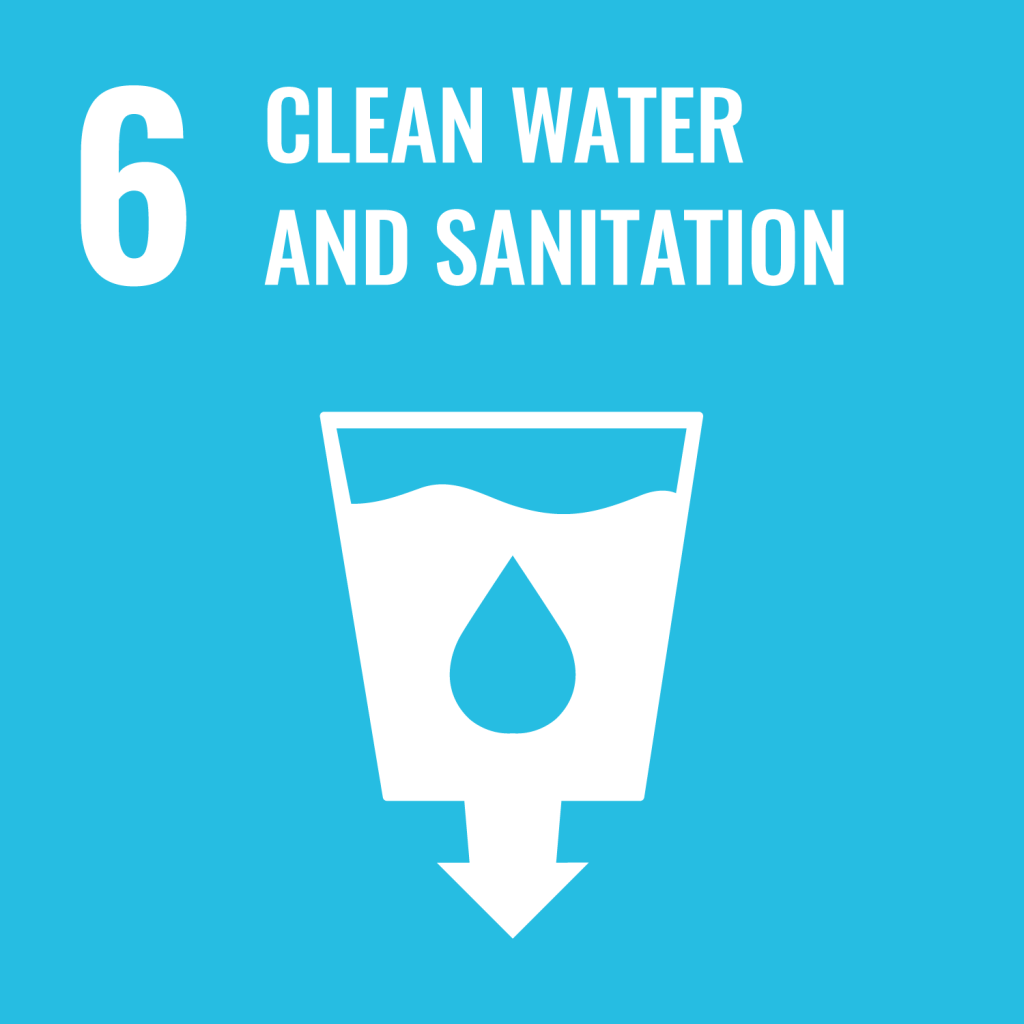
Ensure availability and sustainable management of water and sanitation for all
SDG 6 Indicator
6.3 – Wastewater Treatment
6.3.1 – Wastewater Treatment
Sewage disposal at Universiti Kebangsaan Malaysia (UKM) is managed by the Infrastructure Development Department (JPP), staffed by a team of three mechanical engineers and ten skilled personnel.
Source: https://www.ukm.my/jpp/staff-department/mekanikal/
Diagram below shows that there are 28 sewerage treatment plants at UKM Bangi (SWTP), all equipped with mechanical pump systems and maintained rigorously under JPP oversight. These SWTP stations are essential for effective campus-wide waste management, and their maintenance is entrusted to contractors certified in Three-Phase Electrical Wiring (PW3), ensuring high standards of operational reliability and safety. This structured management aligns with UKM commitment to sustainable and efficient waste treatment practices.
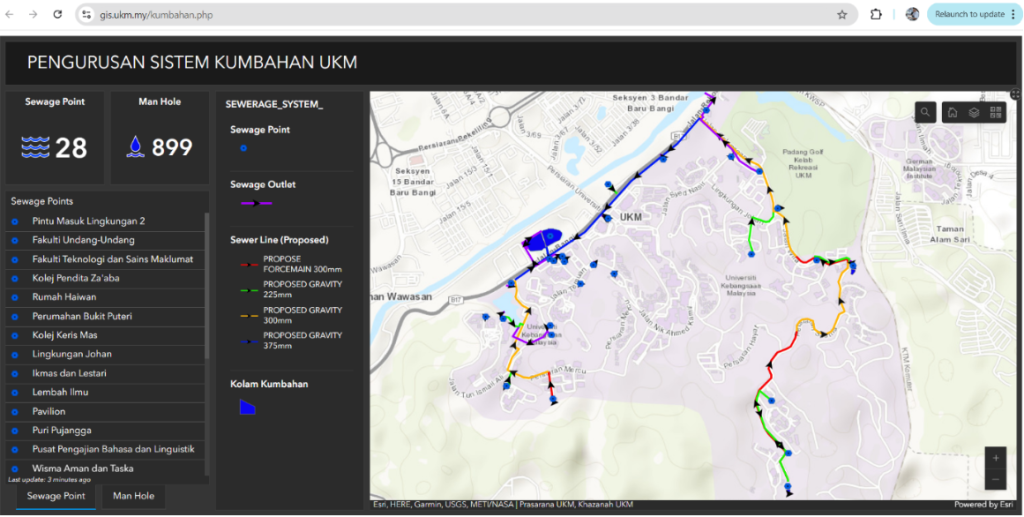
| No | Location | Type | Capacity (PE) | Intake Area |
|---|---|---|---|---|
| 1 | UKM Main Sewage Pond | Oxidation Ponds | 12,000 PE | Chancellery, Tun Seri Lanang Library, PUSANIKA, Dectar Institute of Malay World and Civilisation (ATMA), University Health Centre, Centre For Graduate Studies (PPS), Graduate School of Business (GSB), TNB Engineering Corporation SDN BHD (TNEC), Institute for Environment and Development (LESTARI), Squash UKM, Center for Research and Instrumentation Management (CRIM), Puri Pujangga, Bangunan Wawasan, Faculty of Science and Technology (FST), Faculty of Economics and Management (FEP), Faculty of Social Sciences & Humanities (FSSK), Health Center, Mosque UKM, Kolej Rahim Kajai (KRK), Kolej Dato’ Onn (KDO), Kolej Tun Hussein Onn (KTHO), Kolej Aminuddin Baki (KAB), Kolej Ibrahim Yaakub (KIY), Kolej Burhanuddin Helmi (KBH) and Kolej Ibu Zain (KIZ). |
| 2 | Bukit Puteri Housing | Oxidation Ponds | 500 PE | Quarters UKM, UKM Central Store, Women’s Block at KKM UKM and UKM’s Vehicle Unit |
| 3 | Center For Research in Language and Linguistics (PKBL) | IMHOFF TANK | 500 PE | PKBL, Dewan Tun Abdullah Mohd Salleh (DTAMS), Canteen DTAMS and Store DTAMS, |
| 4 | Faculty of Education (FPEND) | IMHOFF TANK | 500 PE | Faculty of Education (FPEND) |
| 5 | Faculty of Education(FPEND-BLOCK J) | SEPTIC TANK | 150 PE | Faculty of Education (FPEND-BLOCK J) |
| 6 | PRASARANA UKM | IMHOFF TANK | 50 PE | PRASARANA UKM |
| 7 | PALAPES (Old Building) | SEPTIC TANK | 20 PE | PALAPES (Old Building) |
| 8 | PALAPES ( Mess 1 Building) | SEPTIC TANK | 20 PE | Mess Building |
| 9 | PALAPES (Lapang Sasar) | SEPTIC TANK | 10 PE | Lapang Sasar |
| 10 | Malaysian Institute of Environment (EiMAS) | EXTENDED AERATION | 150 PE | Malaysian Institute of Environment (EiMAS) |
| 11 | PERMATApintar Gifted Center (Phase 1) | EXTENDED AERATIONSEPTIC TANK + AERATOR SYSTEM (ACTUAL) | 150 PE | PERMATApintar Gifted Center (Phase 1) |
| 12 | Fuel Cell Institute (SELFUEL) – ECO WISMA | SEPTIC TANK | 20 PE | SELFUEL – ECO WISMA |
| 13 | SELFUEL 1 | SEPTIC TANK | 20 PE | SELFUEL |
| 14 | SELFUEL 2 | SEPTIC TANK | 20 PE | SELFUEL |
| 15 | WORKSHOP / LaboratoryFaculty of Engineering and Built Environment(FKAB) (UNIT 3) | SEPTIC TANK | 30 PE | School of Liberal Studies (CITRA UKM) |
| 16 | ‘Kompleks Rumah Tumbuhan UKM’ | SEPTIC TANK | 50 PE | ‘Kompleks Rumah Tumbuhan UKM’ |
| 17 | Rumah Kayu | SEPTIC TANK | 20 PE | Rumah Kayu |
| 18 | District Cooling System (DCS) Lingkungan 2 | SEPTIC TANK | 20 PE | District Cooling System (DCS) Lingkungan 2 |
| 19 | Earth Observation Centre (EOC), Institute of Climate Change | SEPTIC TANK | 20 PE | Earth Observation Centre (EOC), Institute of Climate Change |
| 20 | School of Liberal Studies (CITRA UKM) | SEPTIC TANK | 50 PE | School of Liberal Studies (CITRA UKM) |
| 21 | UKM’s Tunas Kindergarten | SEPTIC TANK | 30 PE | UKM’s Tunas Kindergarten |
| 22 | UKM Sports Center (University Stadium) | SEPTIC TANK | 30 PE | UKM Stadium |
| 23 | UKM Sports Center (Oval Cricket) | SEPTIC TANK | 30 PE | Cricket Ground |
| 24 | UKM Sports Center (PAVILION) / Arena Azman Hashim | IMHOFF TANK | 30 PE | Pavilion / Arena Azman Hashim |
| 25 | UKM Sports Center (dressing room) | SEPTIC TANK | 10 PE | Dressing Room |
| 26 | UKM Sports Center (Rugby Field Toilet) | SEPTIC TANK | 10 PE | Ukm Sports Center (Rugby Field Toilet) / Cricket Ground |
| 27 | Security Division UKM | SEPTIC TANK | 10 PE | Security Division UKM |

SWTP is a mechanism for a treatment process to separate solid sewage waste from wastewater, which is produced by residential, office or workplace premises. Most of the SWTP stations within UKM were built under the original Act and Law which aims to control and prevent the pollution of rivers and any waters in Malaysia. The following are the Acts and Laws that serve as guidelines for the construction of SWTP in UKM:
1. Environmental Quality Act 1974
Source: https://www.doe.gov.my/wp-content/uploads/2022/11/Environmental_Quality_Act_1974_-_ACT_127.pdf
2. Environmental Quality (SEWAGE) REGULATIONS 2009
Source: https://environment.com.my/wp-content/uploads/2016/05/Sewage.pdf
These treatment processes involve physical, chemical, and biological treatment methods to separate the waste materials from the sewage solid waste and then produce wastewater that is free from pollution and does not pose a threat to Malaysian waters and the life around it. There are 27 SWTP stations operated by a mechanical pump system within UKM. All these SWTP stations are regulated for maintenance and development by UKM Infrastructure Development Department (JPP). Regular maintenance with a frequency of once a month by a panel company appointed by UKM through an open tender method. Among the scope of maintenance work involved are as follows:
- Cleaning the entire SWTP Station area.
- Control panel inspection and testing.
- Inspection and testing of the complete pump system and accessories (‘submersible’/’aerator’/’air blower’/’scum skimmer’).
- Filter inspection and cleaning (‘strainer’/’bar filter’).
- Inspection of the entire pipeline of the SWTP station.
- Inspection and cleaning of chambers (input/transit) or tanks (‘aeration/’clarifier’/’load chamber’), ‘pump sump’ and ‘Filter Dryer Bed’.
Regular maintenance with a frequency of once a month involves works such as ‘housekeeping’ of the SWTP station, inspections of the control panel, inspections of the pump system complete with accessories (‘submersible’/ ‘aerator’/ ‘air blower’/ ‘scum skimmer’ ), inspection-cleaning of filters (‘strainer’/’bar filter’/ gravel/ river stone), inspection of SWTP station pipelines and inspection-cleaning of chambers or tanks (input chamber/ transit chamber/ treatment tank (‘aeration/ ‘clarifier’/ ‘load chamber’)/ ‘pump sump’/ ‘Filter Dryer Bed’ is done by a panel contractor appointed by the UKM Tender Committee. The following are the types of SWTP stations that are operated by mechanical system pumps found in UKM:
- Pump Transit Station
- Oxidation Catchment Pond System
- Extended Aeration System
- Hi-Kleen Tank System
- Imhoff Tank Pump System
- Hybrid Septic Tank System
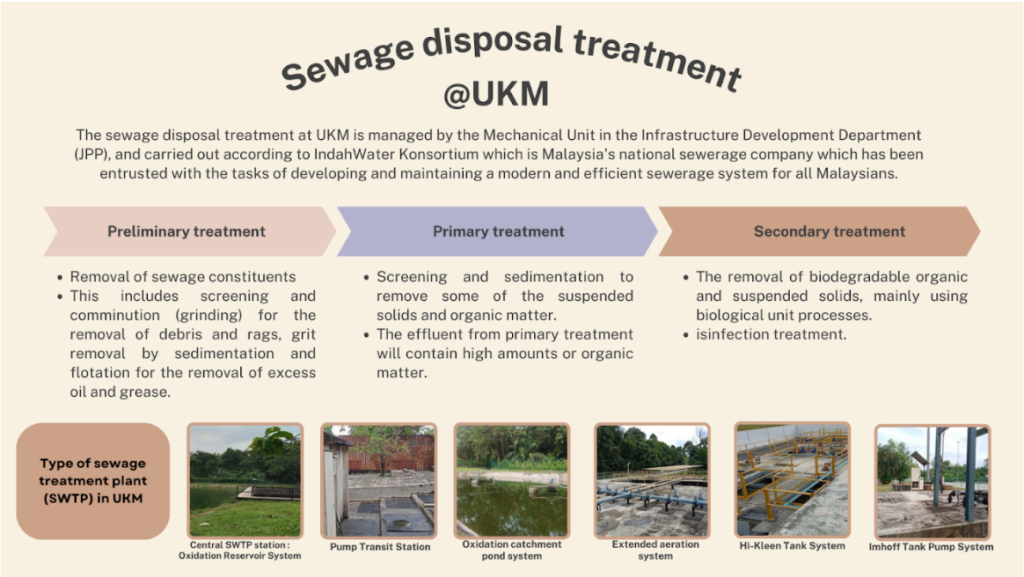
The SWTP station of the Oxidation Catchment Pool system, Extended Aeration, Hi Kleen Tank and Imhoff Tank Pump at UKM will produce effluent (treated wastewater produced through the treatment process) at the end of the treatment process at the station. The effluent will be released into the nearest waters through drains or streams. Figure below shows that it can only be released into the nearest waters after it is found that it meets the requirements based on the guidelines set by the Local Authorities (PBT) such as the PBT of the Department of Environment (JAS) and the National Water Services Commission (SPAN).
The frequency of testing the level of compliance and safety of the influent release is done periodically, which is once every 6 months. This effluent sample will be taken from each SWTP station involved and then taken directly to a laboratory recognized by the Malaysian Standards Department through the Malaysian Laboratory Accreditation Scheme (SAMM). The purpose of this effluent sample being brought to the laboratory is to carry out a data reading analysis test to assess whether the quality of the effluent produced passes by reaching Standard A or Standard B. The effluence that produce from UKM is test in each of the treatment process as shown in Effluent Sewerage Test.
The following figure below, it is the data reading range of 11 parameters that represent the mandatory conditions to be complied with by each effluent sample to determine whether this effluent passes by achieving the quality of Standard A or Standard B because of laboratory analysis tests as follows:

Source: https://environment.com.my/wp-content/uploads/2016/05/Sewage.pdf
Types of SWTP stations that are operated by mechanical system pumps found in UKM
1. Pump Transit Station
SWTP transit station is a station that receives a certain amount of wastewater collected through a ‘local sewage line’ from various related zones before re-pumping this accumulated wastewater out by a ‘submersible pump’ to another Centralized SWTP station of the Oxidation Reservoir type through a main sewage pipeline. This pump operates automatically which is activated by the ‘float switch’ accessory. When the water level has reached the set height level, then the ‘submersible pump’ will operate to suck the water collected in the intake chamber directly to the Central SWTP Station.
The sewage that enters the Pump Transit Station will be filtered through a filter (‘strainer’/’bar filter’) to separate it from any rubbish, solid waste or inorganic impurities before this sewage is collected in the ‘pump sump’ which is then pumped out of the pump to a centralized SWTP station (Oxidation Catchment Pool) for the next effluent treatment process using bacteriological methods.
Regular maintenance with a frequency of once a month involves work such as ‘housekeeping’, control panel inspections, pump system inspections (‘submersible’) complete with related accessories, filter inspections (‘strainer’/’bar filter’), the inspection of SWTP station pipelines as well as inspection-cleaning work of the intake room and transit room.
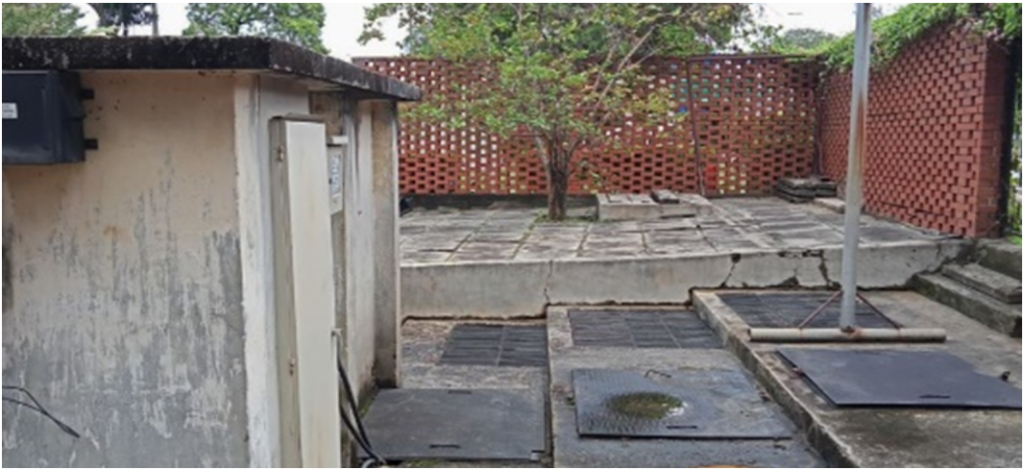
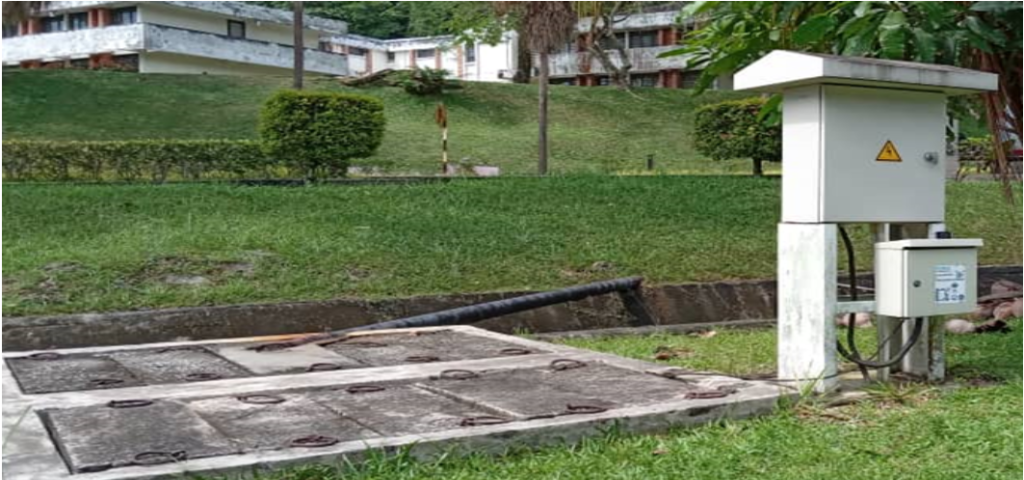
Diagram below shows the pump transit treatment process. This process is a comprehensive wastewater management system designed to efficiently collect, treat, and manage sewage from various sources, including residential, commercial, and industrial premises. This process begins with the collection of wastewater through local sewage lines, which then flows into a designated input room for initial assessment. This process not only ensures the removal of harmful contaminants but also adheres to environmental standards, allowing for the safe discharge or potential reuse of treated water. Continuous monitoring and maintenance are integral to the system, ensuring its efficiency and sustainability. Overall, the pump transit treatment process is vital for protecting public health and maintaining environmental integrity in wastewater management. The pump transit treatment process is as follows:
- Premises from Various Nearby Zones: This is the initial stage where wastewater is generated from different sources, such as residential, commercial, or industrial premises located in the vicinity.
- Local Sewage Line: The wastewater from these premises flows into the local sewage line, which channels it to the input room of the pump transit station.
- Pump Sump: In this stage, the wastewater is collected in a pump sump, which serves to hold and manage the flow of filtered sewage wastewater. This sump helps in regulating the quantity of wastewater that can be processed at any given time.
- Input Chamber: The wastewater enters the input chamber, where it undergoes initial filtration to remove any solid waste or inorganic impurities. This step is crucial to ensure that only clean wastewater proceeds to the next stage, reducing the load on the pumping system.
- Submersible Pump: Once the wastewater is filtered, a submersible pump is utilized to move the collected sewage wastewater to the Central SWTP (Lembaga Rekayasa Kualiti) Station. This pump is submerged in the wastewater and is designed to pump liquids effectively, particularly in areas where gravity flow is insufficient.
- Sewage Wastewater Treatment: After being pumped, the sewage wastewater is treated bacteriologically at the Sepusat SWTP Station, specifically in an oxidation catchment pool. This treatment process helps in breaking down harmful pathogens and pollutants, making the wastewater safer for discharge or further processing.

2. Oxidation Catchment Pond System
The Oxidation Catchment Pond SWTP system is a popular sewage treatment method for a community due to the low cost of construction, operation and maintenance. This system is also one of the types of SWTP stations found in UKM. Usually, these catchment ponds will be built in series with more than one catchment pond for the sewage wastewater treatment process and improve the quality of the effluent wastewater treated at this SWTP station. The natural sewage treatment process is the treatment process concept for this SWTP station. Through this natural process, a combination of microorganism bacteria (‘anaerobic and aerobic’) easily obtain a source of oxygen through an open aeration cycle and through the photosynthesis of algae found in the catchment pond. These bacteria will live and multiply for the continuation of the bacteriological treatment process in the catchment pond of this SWTP station.
The bacteria found in this catchment pool will act as a bacteriological treatment process chain to remove/decompose organic waste from odor and color. This sewage waste will be decomposed into effluent wastewater containing nutrients and carbon dioxide. Next, the chain needs from these nutrients and carbon dioxide will be reused by the algae found in this catchment pond to survive and supply oxygen to the bacteria.
Wastewater that enters the SWTP station will first enter the catchment pond. There is a filter (‘strainer’/’bar filter’) placed in the inlet catchment pool which aims to filter any rubbish, solid waste or inorganic impurities contained with sewage wastewater. Then, the filtered wastewater will flow abundantly into the first catchment pond for the natural treatment process of the first filter. In this first catchment pond, treated decomposed sewage will produce sludge deposits. This sediment will be trapped at the bottom of the first catchment pond with the help of the resulting algae. However, later these deposits will also decompose through natural processes.
As an added value to the quality of the effluent wastewater and the clarity of the processed waste water in the first catchment pond at this SWTP station, a mechanical pump system (‘water waste aerator’) is placed on the surface of the catchment pond. This pump system will operate automatically which is activated by a ‘timer’. Then, this treated sewage waste water will turn into effluent waste water in the first catchment pond and will flow abundantly to the second catchment pond also for the same treatment process in a natural second filter but without sludge deposits. This naturally treated effluent will then flow abundantly into small drains such as drains or small catchment ponds before flowing directly into nearby waters. This effluent sample will also be taken at the Flow Measurement Room to measure the quality level of the effluent to assess the level of pollution risk according to standard A or B perimeter data as set by the local enforcement (DOE – Department of Environment and SPAN – National Water Services Commission).
Regular maintenance with a frequency of once a month involves work such as ‘housekeeping’, inspections of the control panel, inspections of the pump system complete with accessories (‘water waste aerator’), inspections and cleaning of the filter (‘strainer’/’bar filter’ ‘) as well as inspection-cleaning of the inlet chamber (inlet catchment pool). Effluent samples will be taken from the Flow Measurement Room of this SWTP station with a periodic frequency of once every 6 months to be taken to the laboratory for the purpose of testing the data reading analysis on the quality of the effluent to assess whether the quality of the produced effluent passes in compliance with Standard A or Standard B as set by PBT. Based on diagram below, the oxidation catchment pond system process is as follows:
- Sewage Water:
- Definition: This step involves the domestic sewage that is collected from various sources before it enters the treatment system.
- Initial Quality: The sewage may contain a mixture of organic matter, pathogens, and chemicals requiring treatment.
- Input Catchment Ponds:
- Function: The sewage is directed into input catchment ponds, where initial filtration occurs to remove larger particles, solid waste, and inorganic impurities.
- Importance: This step prevents debris from damaging downstream treatment processes and equipment.
- First Reservoir:
- Wastewater Treatment: Water from the catchment ponds flows into the first reservoir, where biological treatment begins.
- Screening: This reservoir serves as the first screening stage, helping to settle solids and allowing for further treatment.
- Natural Process:
- Carbon Dioxide Absorption: This stage relies on natural processes such as photosynthesis and the activities of algae, which help in the degradation of organic matter.
- Role of Algae: A layer of algae forms on the surface, enhancing oxygen levels and facilitating the biological breakdown of pollutants.
- Waste Water Aerator:
- Aeration Process: This component assists in stimulating biological activity, promoting the growth of microorganisms that digest organic matter.
- Purpose: This process enhances the clarity and quality of the wastewater as it moves toward further treatment stages.
- Second Reservoir:
- Biological Treatment: The second reservoir acts as a further treatment zone, where biological processes continue to purify the wastewater.
- Finalization: Here, any remaining contaminants are addressed, ensuring the effluent is treated to a satisfactory level.
- Flow Measurement Room:
- Monitoring: The treated effluent is directed to the flow measurement room, where the volume and quality are assessed.
- Regulatory Compliance: Measurements are crucial for ensuring that the treated effluent meets established standards before discharge or reuse.
- Discharge or Reuse:
- Quality Assurance: Final effluent samples are collected and analyzed to confirm compliance with local regulations.
- End Use: Depending on the treatment level achieved, the effluent may be safely discharged into water bodies or reused for agricultural or industrial purposes.
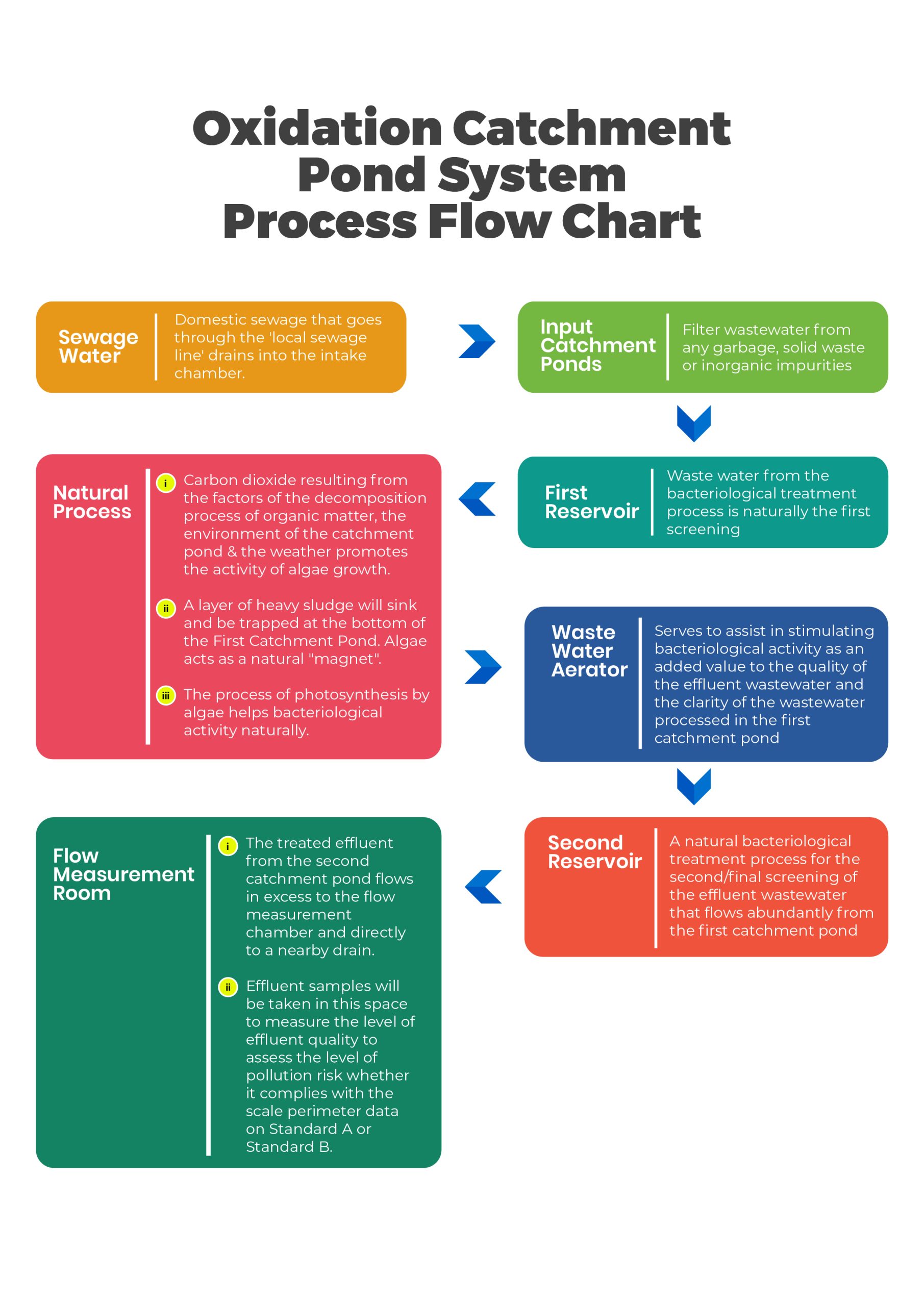




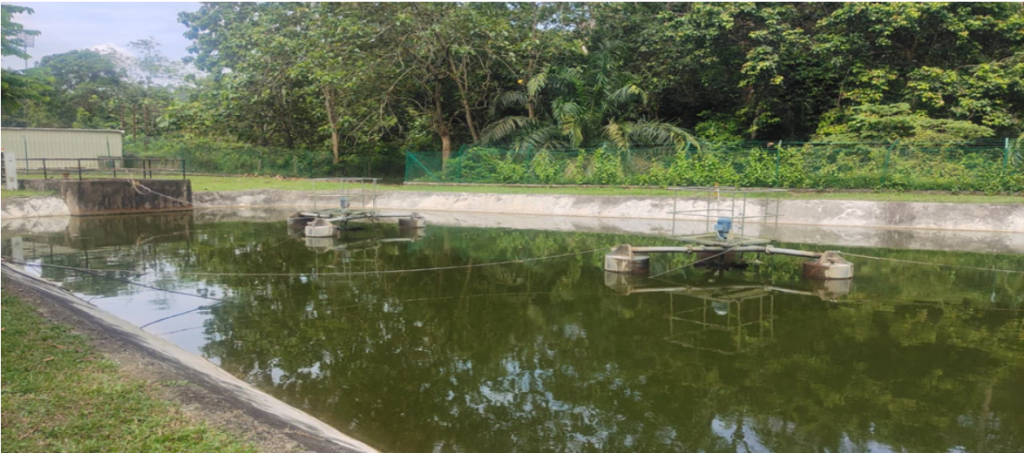
3. Extended Aeration System
The SWTP system Extended Aeration (EA) is one of the types of SWTP stations found in UKM. This system uses bacteriological treatment to remove/decompose organic sewage waste that is free of odor and color through aerobic microorganism bacteria contained in the treatment tank (clarifier & aeration). This system will supply additional oxygen to the bacteria through the operation of the aerator pump which is connected between the diffuser aerator piping and the aeration tank. This oxygen supply will help the bacteria survive and reproduce for the continuation of the bacteriological process in the treatment tank at this SWTP station.
Regular maintenance with a frequency of once a month involves work such as housekeeping of the SWTP station, inspections of the control panel, inspections of the pump system complete with accessories (submersible, aerator/ air blower, scum skimmer), inspection-cleaning of filters (strainer/bar filter), inspection of SWTP station pipelines and inspection-cleaning works of inlet chamber, treatment tank (aeration & clarifier), pump sump and filter dryer bed.
Effluent samples will be taken from the Flow Measurement Room of this SWTP station with a periodic frequency of once every 6 months to be taken to the laboratory for the purpose of testing the data reading analysis on the quality of the effluent to assess whether the quality of the produced effluent passes in compliance with Standard A or Standard B as set by PBT. Based on diagram below, extended aeration system process is as follows:
- Sewage Water:
- Definition: This stage involves the collection of domestic sewage that flows through local sewage lines into the intake chamber for treatment.
- Characteristics: The sewage typically contains organic matter, nutrients, and potential pollutants that require treatment before discharge.
- Enter Chamber:
- Initial Filtration: Wastewater first enters the enter chamber, where it undergoes filtration to remove any garbage, solid waste, or inorganic impurities.
- Purpose: This initial step is critical for protecting downstream equipment and ensuring efficient processing of the wastewater.
- Pump Sump:
- Transfer Point: The filtered wastewater is collected in the pump sump, which acts as a holding area before transferring the water to the next stage.
- Operation: This sump uses pumps to transport the wastewater into the transit chamber, facilitating further aeration or secondary filtration.
- Aeration Tank:
- Biological Treatment: In the aeration tank, bacteria are utilized to treat the wastewater through a biological process. This tank provides additional oxygen through an air blower or aerator pump to support bacterial growth.
- Process Mechanism: The microorganisms break down organic matter, effectively reducing the biochemical oxygen demand (BOD) and improving water quality.
- Clarifier Tank:
- Separation Process: The effluent wastewater flows into the clarifier tank, where it undergoes sedimentation. This tank is designed to separate treated effluent from sludge and impurities.
- Function: Heavier solids settle at the bottom, while lighter sludge is trapped, allowing the clarified water to flow to subsequent treatment stages.
- Sludge Tank:
- Collection of Heavy Pollutants: The sludge tank collects remaining heavy pollutants that settle from the clarifier. It is equipped with a scum skimmer pump to remove excess sludge.
- Management of Waste: This tank is crucial for managing waste, ensuring that pollutants are properly contained and processed.
- Filter Dryer Bed:
- Final Treatment: The sludge collected in the sludge tank is transported to the filter dryer bed, where it undergoes dewatering. This step helps to reduce the volume of waste while leaving it compact for disposal.
- Effluent Quality: This process not only facilitates easier handling of sludge but also improves the overall quality of the effluent treated in the system.
- Flow Measurement Room:
- Monitoring and Compliance: The effluent that has been treated and flows out of the clarifier tank is monitored in the flow measurement room. Samples are collected for quality assessment to ensure compliance with local environmental standards (Standard A or B).
- Purpose of Samples: This regular monitoring is essential for evaluating the treatment process and mitigating potential pollution risks associated with wastewater discharge.
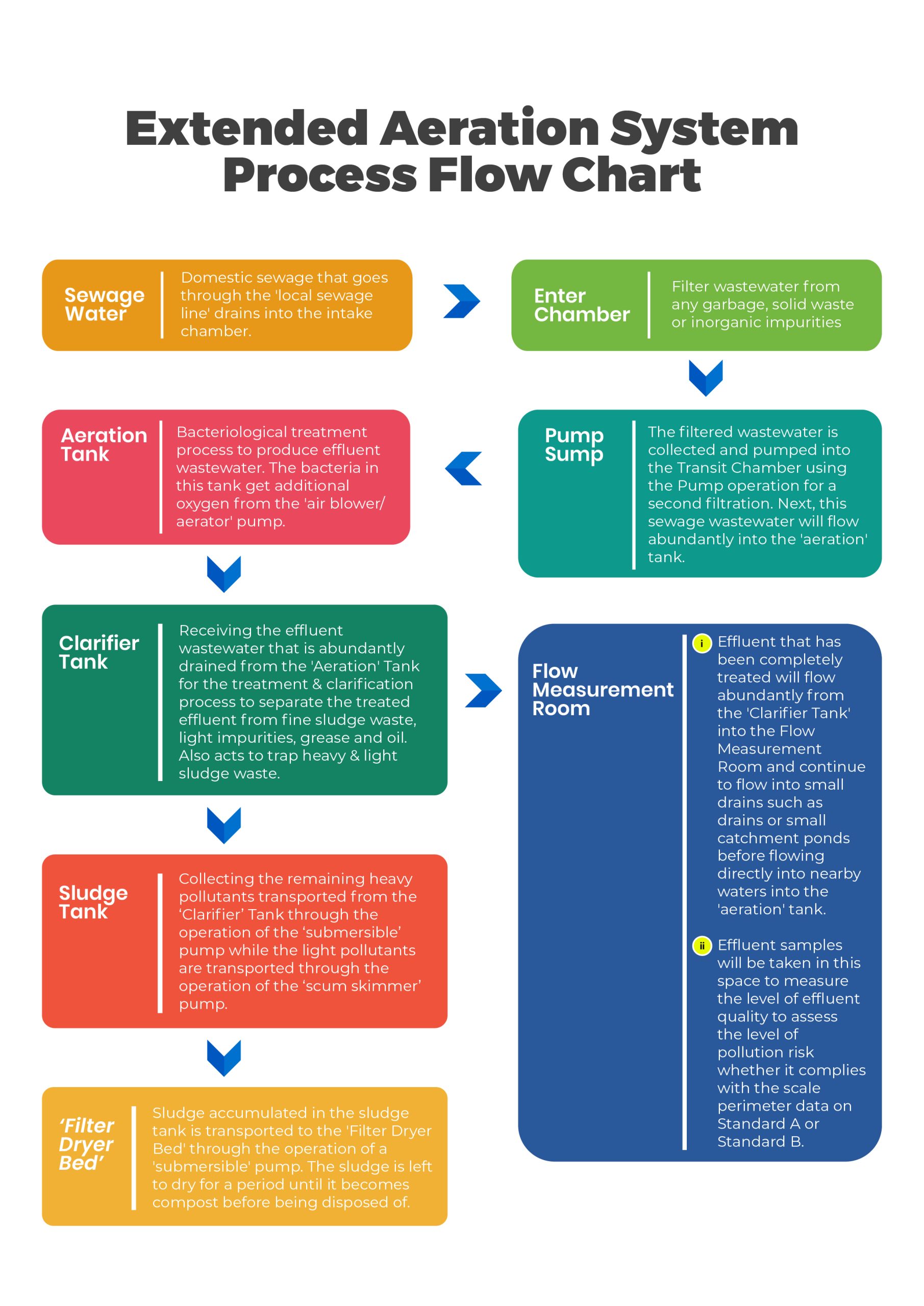









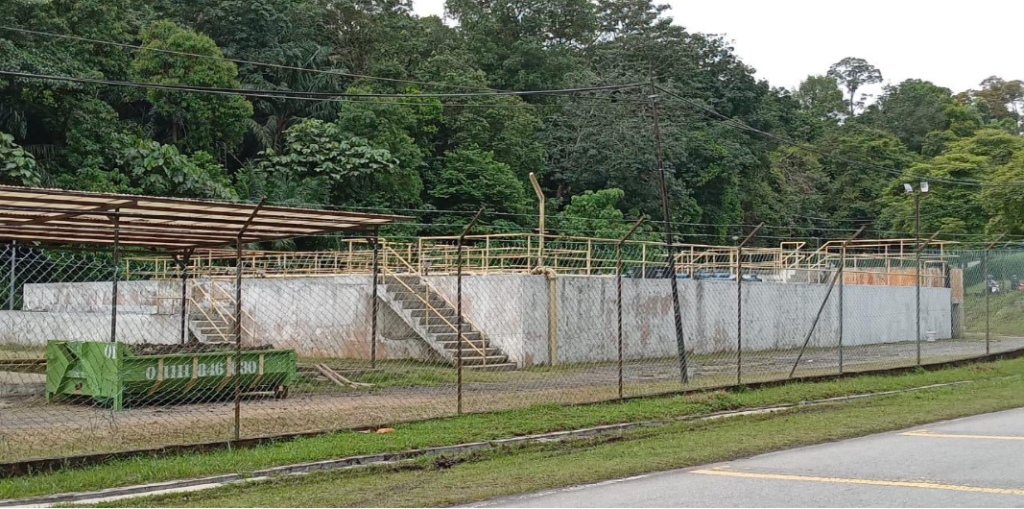
4. Hi-Kleen Tank System
The Hi-Kleen Tank SWTP system is also one of the SWTP stations found in UKM. The sewage treatment process at this station is almost the same as the ‘Extended Aeration’ System, but there is no use of ‘Filter Dryer Bed’ and ‘scum skimmer’ pump. to collect the remaining sludge deposits. This system also uses bacteriological treatment to remove/decompose organic sewage waste that is free of odor and color through ‘aerobic’ microorganism bacteria contained in the treatment tank (‘clarifier’ & ‘aeration’). This system will supply additional oxygen to the bacteria through the operation of the ‘aerator’ pump which is connected between the ‘diffuser aerator’ piping and the ‘aeration’ tank. This oxygen supply will help the bacteria survive and multiply for the continuation of the bacteriological process in the treatment tank at this SWTP station.
Periodic maintenance with a frequency of once a month involves work such as SWTP station housekeeping, control panel inspections, pump system inspections complete with accessories (‘submersible’ & ‘aerator’/ ‘air blower’), cleaning inspections filter (‘strainer’/’bar filter’), inspection of SWTP station pipelines and inspection-cleaning work of inlet chamber, treatment tank (‘aeration & clarifier’) and ‘pump sump’. Effluent samples will be taken from the Flow Measurement Room of this SWTP station with a periodic frequency of once every 6 months to be taken to the laboratory for the purpose of testing the data reading analysis on the quality of the effluent to assess whether the quality of the produced effluent passes in compliance with Standard A or Standard B as set by PBT. The summaries of the process shown in diagram below is as follows:
- Sewage Wastewater:
- Definition: This stage involves the collection of domestic sewage that flows through local sewage lines into the intake chamber.
- Characteristics: The sewage typically contains a mix of organic matter, nutrients, and pollutants that require treatment to ensure environmental compliance.
- Enter Chamber:
- Initial Filtration: Wastewater first enters the enter chamber, where it is filtered to remove garbage, solid waste, and inorganic impurities.
- Purpose: This initial step protects downstream equipment and ensures a more effective treatment process.
- Pump Sump:
- Transfer Point: The filtered wastewater is collected in the pump sump, which serves as a holding area before being pumped into the transit chamber for further filtration.
- Operational Role: This sump facilitates the continuous movement of wastewater to the next treatment stage.
- Aeration Tank:
- Biological Treatment: In the aeration tank, a bacterial treatment process occurs to produce effluent wastewater. The bacteria thrive in this tank with additional oxygen supplied by an air blower or aerator pump.
- Mechanism: Microorganisms break down organic matter and pollutants, improving the overall quality of the wastewater.
- Clarifier Tank:
- Sedimentation Process: The effluent wastewater is directed into the clarifier tank, where it undergoes sedimentation. This tank is crucial for separating treated effluent from heavier solids and impurities.
- Functionality: Fine sludge settles at the bottom, while grease and light sludge are trapped, allowing for the clarified water to be further processed.
- Sludge Tank:
- Collection of Pollutants: The sludge tank collects remaining heavy pollutants that settle from the clarifier. It is operated by a submersible pump that helps manage excess sludge.
- Waste Management: This stage is essential for containing pollutants and preparing them for appropriate disposal or further treatment.
- Measurement Room:
- Quality Assessment: The treated effluent, having flowed from the clarifier tank, is monitored in the measurement room. This space is designated for evaluating the quality of the effluent before discharge.
- Pollution Risk Assessment: Samples are taken to assess the pollution risk, ensuring compliance with environmental standards (Standard A or B).
- Continuous Monitoring: The treated water continues to flow into small drains or ponds before being released, facilitating ongoing assessment of water quality.









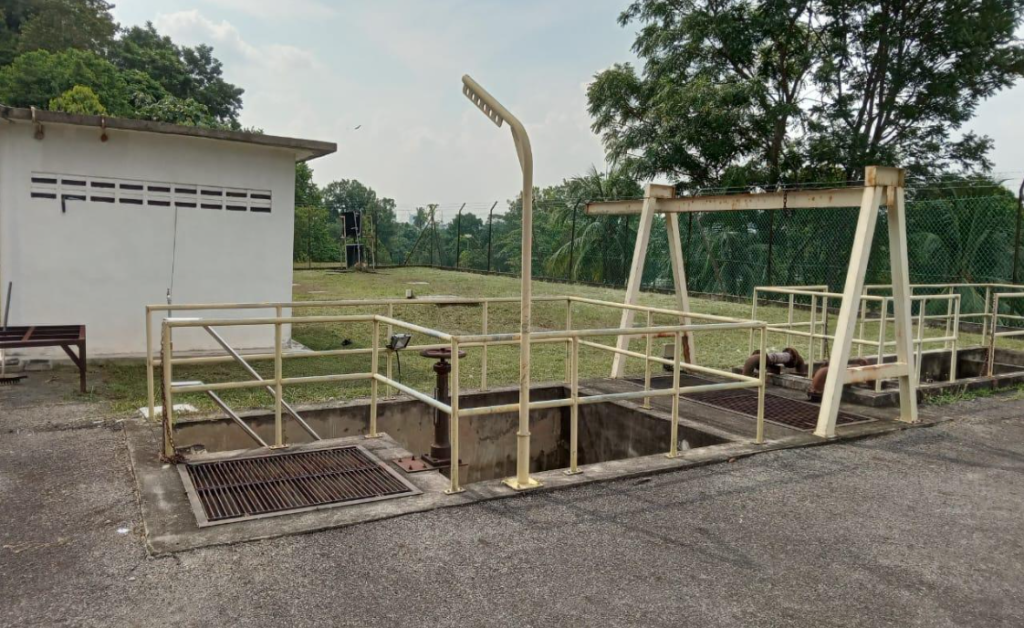

5. Imhoff Tank Pump System
The ‘Imhoff’ Tank SWTP system is a combination of a ‘submersible’ pump system with old technology to produce a better-quality effluent from the old ‘Imhoff’ Tank SWTP technology where this SWTP station is capable of processing sewage wastewater with a high PE capacity. This system is also one of the SWTP stations found in UKM.
Usually, the old SWTP technology of the old ‘Imhoff’ Tank without the aid of pump operation is used by small communities just to cover the low PE capacity. Because this system has been modified for the use of a relatively high PE capacity, the relatively wide and large size of SWTP Tanki ‘Imhoff’ is also used and built with concrete construction below the ground surface. Only the ‘Filter Dryer Bed’ will be built on the ground next to this tank.
This system uses bacteriological treatment to remove/decompose organic sewage waste that is free of odor and color through ‘aerobic’ microorganism bacteria contained in the treatment tank. This system gets oxygen supply to stimulate bacterial activity through the construction of several air channel ‘diffuser’ units on the surface of the tank which functions to get oxygen from the gauze air as a natural ventilation cycle. This oxygen supply will help the bacteria to survive and reproduce for the continuation of the bacteriological process in the treatment tank at this SWTP station.
Regular maintenance with a frequency of once a month involves work such as ‘housekeeping’ of the SWTP station, inspections of the control panel, inspections of the pump system complete with accessories (‘submersible’), inspections and cleaning of filters (‘strainer’/’bar filter’ ‘ and gravel/river stones), inspection of SWTP station pipelines, inspection-cleaning works of intake chamber, treatment tank (‘load chamber’), ‘pump sump’ and ‘Filter Dryer Bed’.
Effluent samples will be taken from the Flow Measurement Room of this SWTP station with a periodic frequency of once every 6 months to be taken to the laboratory for the purpose of testing the data reading analysis on the quality of the effluent to assess whether the quality of the produced effluent passes in compliance with Standard A or Standard B as set by PBT. Diagram below shown the imhoff tank pump system:






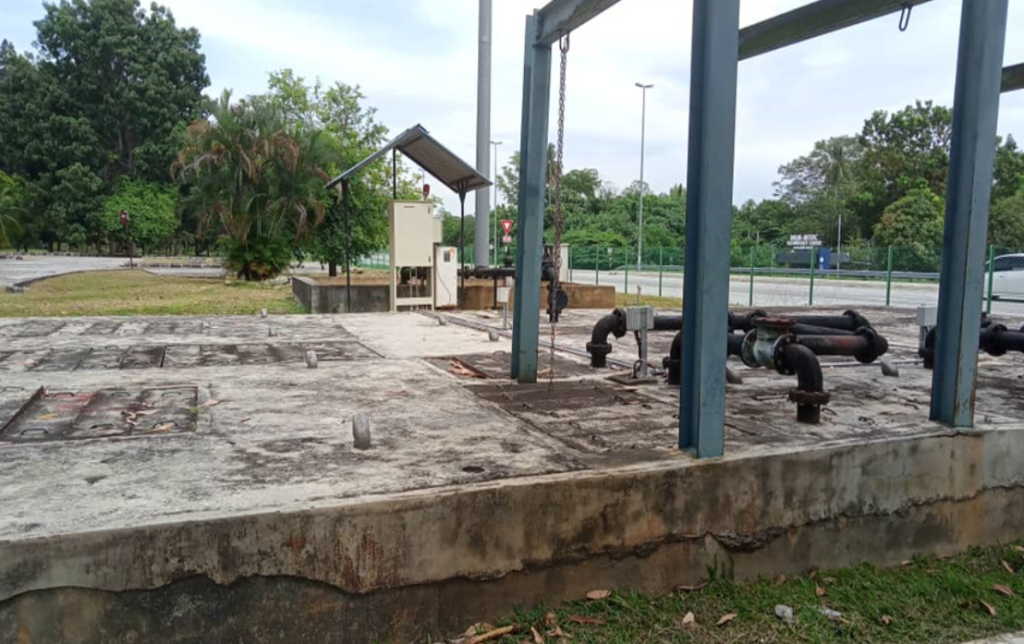
Additional Evident:
Effluence Sampling
UKM will undergo water quality or sewerage water sampling to ensure and monitor wastewater quality and ensure compliance with environmental regulations before entering water bodies. Figure below shows the results of water quality on wastewater treatment in UKM Bangi. Effluent sampling is a crucial component of wastewater management at UKM, ensuring that treated water meets environmental regulations and standards. This process involves collecting water samples from various points in the wastewater treatment system to monitor quality and assess the efficiency of treatment processes. Here’s an overview of the practices and methodologies involved in effluent sampling at UKM:
- Purpose of Effluent Sampling
- Regulatory Compliance: Ensure that treated effluent meets the standards set by local environmental authorities (e.g., Department of Environment (DOE) and National Water Services Commission (SPAN)).
- Quality Monitoring: Continuously monitor the quality of effluent to detect any changes in composition or potential contamination.
- Process Optimization: Use sampling data to assess the efficiency of treatment processes and make necessary adjustments to improve overall performance.
- Sampling Locations
- Treatment Facilities: Samples are typically taken from various points in the wastewater treatment facilities, including:
- Influent and Effluent Points: To compare incoming sewage with treated effluent.
- Clarifier Tanks: To assess the effectiveness of sedimentation processes.
- Final Effluent Discharge Points: To ensure compliance before discharge into receiving water bodies.
- Environmental Monitoring Stations: Additional samples may be collected from local water bodies to assess the impact of treated effluent on the environment.
- Treatment Facilities: Samples are typically taken from various points in the wastewater treatment facilities, including:
- Sampling Methods
- Grab Sampling: Collecting a single sample at a specific time to provide a snapshot of effluent quality. This method is often used for routine monitoring.
- Composite Sampling: Combining multiple samples taken over a specific period to obtain a representative sample of effluent quality. This method is beneficial for assessing variability over time.
- Automated Sampling: Utilizing automated samplers to collect samples at predetermined intervals, ensuring consistent and reliable data collection.
- Analysis and Testing
- Laboratory Analysis: Collected samples are sent to laboratories for analysis of key parameters, including:
- Biochemical Oxygen Demand (BOD)
- Chemical Oxygen Demand (COD)
- Total Suspended Solids (TSS)
- Nutrient Levels (Nitrogen, Phosphorus)
- Pathogen Levels
- Standard Compliance: Testing results are compared against established regulatory standards (e.g., Standard A or B) to determine compliance.
- Laboratory Analysis: Collected samples are sent to laboratories for analysis of key parameters, including:
- Data Management and Reporting
- Record Keeping: Detailed records of sampling dates, locations, methods, and analysis results are maintained for transparency and compliance purposes.
- Reporting: Regular reports are generated to communicate findings to relevant stakeholders, including university management and regulatory bodies.
- Continuous Improvement
- Feedback Mechanisms: Sampling data is used to identify areas for improvement in the wastewater treatment process.
- Training and Capacity Building: Staff involved in effluent sampling and monitoring receive training to stay updated on best practices and regulatory requirements.


Example of Results of Water Quality on Wastewater Treatment in UKM Bangi
Sewerage Maintenance
UKM Bangi, Sewerage treatment undergoes annual maintenance which is essential for ensuring the effective operation of wastewater treatment facilities. Diagram below shows the record on sewage treatment maintenance in UKM Bangi. Sewerage maintenance is a critical aspect of ensuring effective wastewater management and environmental sustainability at UKM. The maintenance processes involve regular inspections, cleaning, and repairs of sewer infrastructure to prevent blockages, leaks, and system failures. Here’s an overview of the key practices and strategies involved in sewerage maintenance at UKM:
- Regular Inspections
- Frequency: Routine inspections of the sewerage system are conducted to identify potential issues such as blockages, corrosion, or structural damage.
- Methods: Visual inspections, CCTV surveys, and sonar equipment may be employed to assess the condition of sewer pipes and catchment areas.
- Cleaning and Clearing
- Hydro Jetting: High-pressure water jetting is often used to clear blockages and remove debris from sewer lines, ensuring smooth flow and preventing backups.
- Manual Cleaning: In certain areas, manual cleaning may be necessary, particularly for smaller drains or catchment pits where mechanical methods are not feasible.
- Maintenance of Pump Stations
- Regular Checks: Maintenance teams routinely check pump stations for proper operation, including pump performance, electrical systems, and alarm systems.
- Pump Servicing: Scheduled servicing of pumps ensures they operate efficiently and are ready to handle wastewater flow without interruption.
- Sludge Management
- Sludge Removal: Regular removal of sludge from treatment facilities and holding tanks is essential for maintaining system efficiency and preventing odor issues.
- Dewatering: Dewatering processes may be implemented to reduce sludge volume before disposal or further treatment.
- Emergency Response
- Rapid Response Teams: UKM has established protocols for responding to sewerage emergencies, such as leaks or major blockages, to minimize environmental impact and ensure public safety.
- Collaboration with Local Authorities: Coordination with local environmental and public health agencies helps address emergency situations effectively.
- Compliance and Monitoring
- Regulatory Compliance: UKM sewerage maintenance practices adhere to local environmental regulations and standards, ensuring the safe treatment and discharge of wastewater.
- Monitoring Systems: Implementation of monitoring systems for effluent quality, flow rates, and system performance helps ensure continuous compliance and identify potential issues early.
- Public Awareness and Education
- Awareness Programs: UKM promotes public awareness about proper waste disposal practices to minimize contamination and protect the sewerage system.
- Educational Initiatives: Workshops and seminars may be conducted to educate the university community about the importance of sewerage maintenance and environmental stewardship.
The sewerage maintenance program at UKM is vital for ensuring efficient wastewater management and protecting environmental health. Through regular inspections, cleaning, and effective management practices, UKM is committed to maintaining a sustainable and functional sewerage system that meets the needs of its community while adhering to regulatory standards.








List of Record on Sewage Treatment Maintenance in UKM Bangi
UKM has implemented a comprehensive wastewater treatment system, featuring six types of Sewage Treatment Plants (STPs) across 28 locations. These systems utilize mechanical, biological, and chemical processes to treat wastewater, ensuring it meets local environmental standards before being safely discharged into nearby water bodies. UKM conducts annual tests on effluent samples to ensure and monitor wastewater quality and ensure compliance with environmental regulations quality regulations. UKM Bangi, Sewerage treatment undergoes annual maintenance which is essential for ensuring the effective operation of wastewater treatment facilities. This system supports the university’s sustainability efforts by promoting water reuse, minimizing environmental impact, and contributing to water conservation in alignment with SDG 6: Clean Water and Sanitation.
